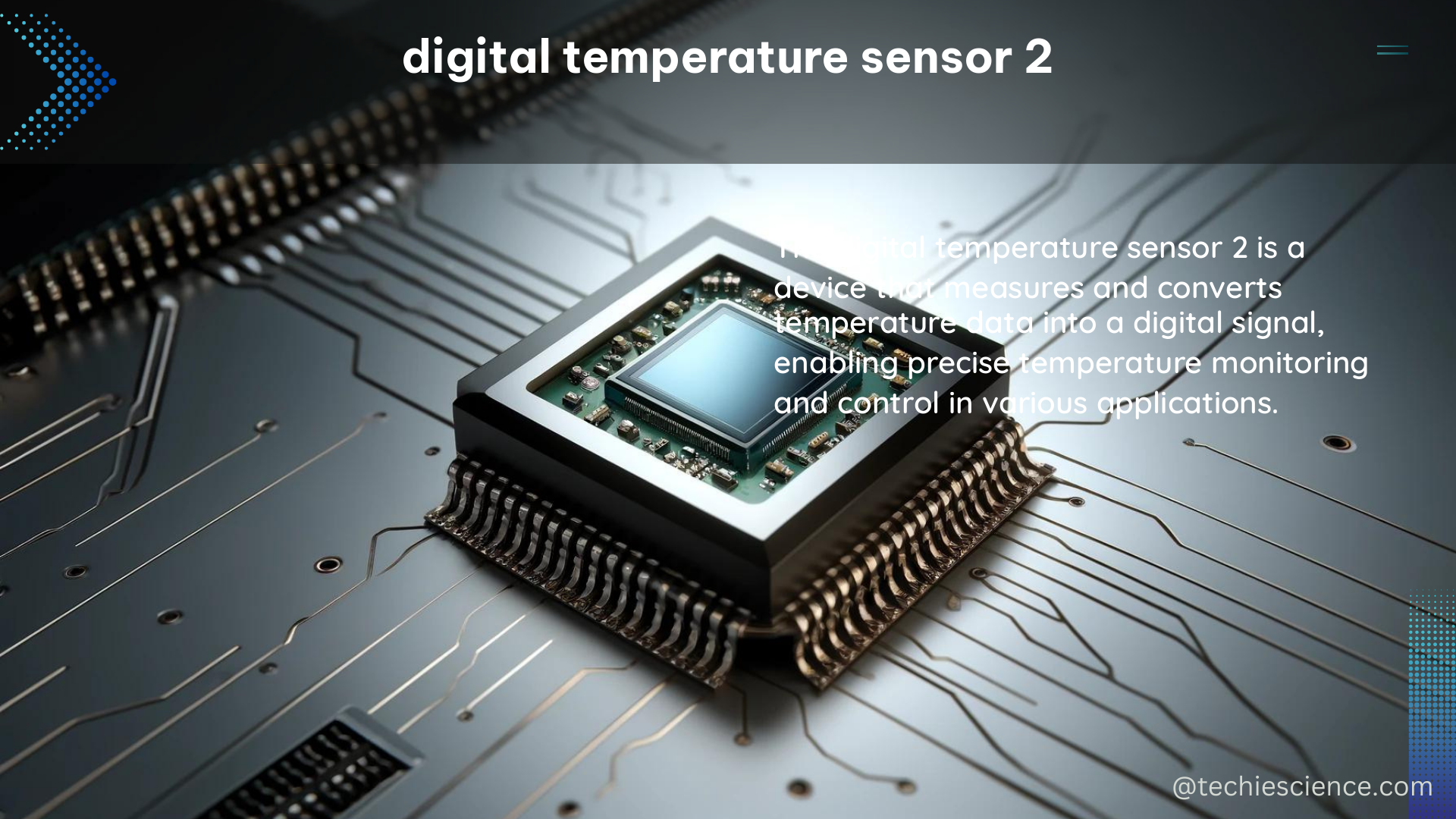Digital temperature sensor 2, also known as semiconductor temperature sensors, operate based on the change of voltage across a p-n junction, which exhibits strong thermal dependence. These sensors are widely used in various applications, from industrial automation to consumer electronics, due to their accuracy, reliability, and ease of integration.
Key Performance Indicators (KPIs) of Digital Temperature Sensor 2
-
Resolution: The resolution of digital temperature sensor 2 can range from 0.01°C to 0.0001°C, depending on the specific model and manufacturer. Higher-end sensors can achieve a resolution of 0.0001°C, allowing for precise temperature measurements.
-
Accuracy: The accuracy of digital temperature sensor 2 is typically within ±0.1°C to ±0.5°C, with some high-precision models achieving an accuracy of ±0.05°C or better. This level of accuracy is suitable for a wide range of applications, from environmental monitoring to medical equipment.
-
Precision: Digital temperature sensor 2 can achieve a precision of up to ±0.01°C, ensuring consistent and repeatable measurements. This is particularly important in applications where temperature stability is critical, such as in scientific research or industrial process control.
-
Hysteresis: The hysteresis of digital temperature sensor 2 is typically less than 0.1°C, meaning that the sensor’s output will not vary significantly between rising and falling temperature inputs. This helps to ensure accurate and reliable temperature measurements.
-
Temperature Coefficient: The temperature coefficient of digital temperature sensor 2 is typically in the range of 0.01% to 0.1% per degree Celsius, depending on the sensor type and design. This low temperature coefficient ensures that the sensor’s output remains stable and consistent over a wide temperature range.
Technical Specifications of Digital Temperature Sensor 2

-
Operating Temperature Range: Digital temperature sensor 2 can operate in a wide temperature range, typically from -55°C to +150°C. This makes them suitable for use in a variety of environments, from cryogenic applications to high-temperature industrial processes.
-
Response Time: The response time of digital temperature sensor 2 is typically less than 100 milliseconds, allowing for rapid temperature measurements and real-time monitoring.
-
Power Consumption: Digital temperature sensor 2 generally have a low power consumption, often less than 1 milliwatt. This makes them suitable for battery-powered or energy-efficient applications.
-
Packaging: Digital temperature sensor 2 are available in a variety of packaging options, including surface-mount, through-hole, and integrated circuit (IC) packages. This allows for easy integration into various electronic systems and circuits.
Building a Temperature Monitoring System with Digital Temperature Sensor 2
To build a temperature monitoring system using digital temperature sensor 2, you will need the following components:
- Digital temperature sensor 2 (e.g., LM35, DS18B20, or TMP36)
- Microcontroller (such as Arduino or Raspberry Pi)
- Breadboard and jumper wires
- Display (such as an LCD or OLED display)
- Power supply (such as a battery or USB power bank)
The digital temperature sensor 2 can be connected to the microcontroller using the breadboard and jumper wires. The microcontroller can then be programmed to read the temperature data from the sensor and display it on the display. The power supply can be connected to the microcontroller to provide power to the entire system.
When building the temperature monitoring system, it is important to consider the following factors:
- Sensor Placement: Ensure that the digital temperature sensor 2 is placed in a location that accurately represents the temperature of the environment or object being monitored.
- Calibration: Calibrate the digital temperature sensor 2 to ensure accurate temperature readings. This can be done using a two-point calibration method.
- Data Logging: Implement data logging functionality to record temperature data over time, which can be useful for analysis and monitoring purposes.
- Alarm Functionality: Add alarm functionality to the system, which can notify the user when the temperature exceeds or falls below a certain threshold.
- Connectivity: Integrate the temperature monitoring system with other devices or cloud-based platforms for remote monitoring and control.
By following these guidelines and leveraging the capabilities of digital temperature sensor 2, you can create a robust and reliable temperature monitoring system for a wide range of applications.
Conclusion
Digital temperature sensor 2 are versatile and accurate temperature sensors that can be used in a variety of applications. With their high resolution, precision, and low temperature coefficient, these sensors are well-suited for demanding temperature monitoring and control applications. By understanding the key performance indicators and technical specifications of digital temperature sensor 2, you can select the right sensor for your project and build a reliable temperature monitoring system.
References
- Gyorki, L. (2009). Sensing and Sensor Fundamentals. In Sensing and Sensor Fundamentals (pp. 15-34). Springer.
- Lake Shore Cryotronics, Inc. (2012). Temperature Measurement and Control Catalog. Retrieved from https://www.lakeshore.com/docs/default-source/product-downloads/lakeshoretc_l.pdf
- Salinas, J., Hogan, J., Headrick, J., & Unsplash. (2010-2015). Achieving continuous improvement in laboratory organization through performance measurements: a seven-year experience. Retrieved from https://irp.fas.org/doddir/dod/jp2-01-3.pdf
- Texas Instruments. (2015). LM35 Precision Centigrade Temperature Sensors. Retrieved from https://www.ti.com/lit/ds/symlink/lm35.pdf
- Maxim Integrated. (2019). DS18B20 Programmable Resolution 1-Wire Digital Thermometer. Retrieved from https://datasheets.maximintegrated.com/en/ds/DS18B20.pdf
- Analog Devices. (2020). TMP36 Low Voltage Temperature Sensors. Retrieved from https://www.analog.com/media/en/technical-documentation/data-sheets/TMP35_36_37.pdf

The lambdageeks.com Core SME Team is a group of experienced subject matter experts from diverse scientific and technical fields including Physics, Chemistry, Technology,Electronics & Electrical Engineering, Automotive, Mechanical Engineering. Our team collaborates to create high-quality, well-researched articles on a wide range of science and technology topics for the lambdageeks.com website.
All Our Senior SME are having more than 7 Years of experience in the respective fields . They are either Working Industry Professionals or assocaited With different Universities. Refer Our Authors Page to get to know About our Core SMEs.